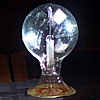-

-
Courses
Find courses by:
Collections
Cross-Disciplinary Topic Lists
- About
- Donate
- Featured Sites

 |
|
By the end of this lecture, you should:
› View/hide answer
The skin depth is in this case \[\delta = \sqrt {\frac{2}{{\omega {\mu _0}\sigma }}} = \sqrt {\frac{2}{{2\pi f(4\pi \times {{10}^{ - 7}})(5)}}} = \frac{{225}}{{\sqrt f }}m.\] Light is mentioned in the lecture as having f = 5 × 1014 Hz, so the formula implies a skin depth of \[\delta = \frac{{225}}{{\sqrt {5 \times {{10}^{14}}} }} = {10^{ - 5}}m.\] Anyone who has seen the bottom through many meters of clear sea water will know this cannot be true and that some other physical process must take over at optical frequencies. On the other hand, at the given radio frequency, we get \[\delta = \frac{{225}}{{\sqrt {100 \times {{10}^3}} }} = 0.7m.\] A submarine can only communicate at this frequency if it is on the surface, which defeats most of the advantages of being a submarine. In practice, submarine communication is done with huge antennas operating at extremely low frequencies.
› View/hide answer
Since, apart from some cases where we would need to be careful, as discussed in the previous question, the skin depth is very small for good conductors, we can treat their surfaces as sharp boundaries, easier to handle mathematically than the real situation where the fields decrease in a complicated fashion (but quickly). We will make very little error in doing that even for time-varying fields, as long as the wavelength is long compared to the skin depth.
› View/hide answer
In addition to the assumption about a small skin depth, we assume that the conductor can supply any required charge to meet the boundary condition, essentially instantaneously.
› View/hide answer
The radiation pressure is \[P = \frac{{ < S > }}{c} = \frac{{1400}}{{3 \times {{10}^8}}} = 5 \times {10^{ - 6}}N/m^2.\] Twice this pressure would be the force on one square meter (which has mass 10 g = 0.01 kg), due to the reflection. The acceleration would be \[a = \frac{F}{m} = 2\frac{{5 \times {{10}^{ - 6}}}}{{0.01}} = {10^{ - 3}}ms^{-2}.\] Although this is a very small acceleration, if consistently applied as needed, and to a body already in the balance of major forces that allows it to be in orbit, it could allow "fuel-free" travel. This calculation, however, neglects the mass of support structures and other parts of the solar spacecraft. Including these would make the acceleration less.
› View/hide answer
Even though the cable is wound up, any local section of it is like a cylinder since the cable diameter would be much less than the size of the coil. A 100 ns long pulse, positive on the center wire, results in a radially outward electric field. The pulse travels at .65c so its length is \[l = v\Delta t = .65(3 \times {10^8})(100 \times {10^{ - 9}}) = 19.5m,\] much less than the cable’s length. The radially outward electric field corresponds to a positive surface charge on the inner conductor, a negative surface charge on the outer conductor, and polarization of the dielectric between them. In between pulses, there is no surface charge, nor dielectric polarization. This pattern of surface charge and polarization moves along the cable.